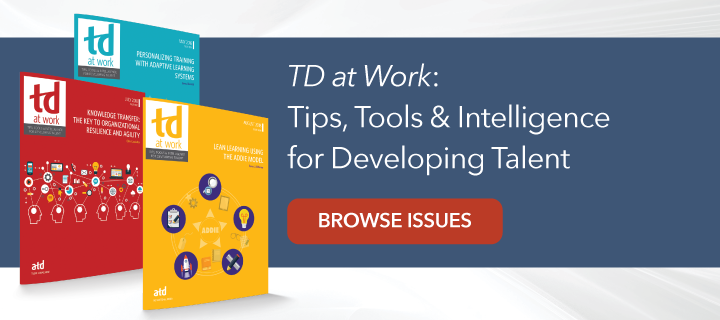As an talent development professional, what do you do to maximize engagement and motivation of your learners?
At one time, we may have thought about this question in terms of a trainer using storytelling, humor, and breaking up modules to mix small group activities along with presentation during their training course.
Today an L&D professional needs to consider learner engagement much earlier in the formulation of learning. That is true for a number of reasons: reduced attention span, whether learning is beyond the scope of the training course, and competing priorities in today’s world. So thinking about engaging the learner begins with designing engaging content.
To do so, an instructional designer can consider elements used by the trainer—storytelling, human, hands-on activities, and visual elements. But engaging learners also means setting learning objectives, identifying relevant and irrelevant content, and creating a logical flow to that content.
As you determine these latter elements, you’ll want to hold conversations with relevant stakeholders: What learning is needed to align with organizational goals and mission, what does the business owner need their staff to understand and know how to do, and do you have buy-in from the training delivery team for the types of content you envision creating? You also need to consider time and budget relating to designing content: Do you have time to pilot strategies and test different methods? Will the content you envision creating need to be refreshed frequently yet come with a large price tag? If yes on this last point, you may want to reconsider your format.
The next step, as Rashim Mogha describes in “Foster Learning Through Engaging Content,” is developing engaging content. Simulations, gamifications, microlearning, and storytelling are all methods to ensure that learners are engaged. When developing microlearning segments, for example, keep these guidelines in mind:
- Have one objective per topic. Microlearning segments are generally two to five minutes in length (though they can be longer) and are dedicated to one topic. Calibrate the duration based on your target audience and the type of content.
- Keep content lean. Microlearning, by definition, is short and targeted. Cut out anything extraneous.
- Remember to include variety. Yes, you’re creating short segments, but you’ll want to include different types of content for your microlearning bursts and sew them together seamlessly. Visuals are helpful to keep learners engaged.
- Build in personalized learning paths. Based on learner responses, create learning paths. As Mogha explains, “This will help learners focus on the skills they require to reach their individual goals.”
At this point, you are ready to deploy content that will keep learners focused and wanting to learn. Social and adaptive learning platforms are two good options. Social learning is informal, and happens when individuals collaborate, network, and exchange ideas. As an L&D professional, you can also weigh in when learners are doing so, asking learners provocative questions in response to content they’ve posted, for example.
Guidelines for creating social learning content include:
- Choose the right platform. Pick a platform that allows learners to interact via chat and real-time discussions, and to share media, for example. Consider whether your learners are comfortable with the platform you are evaluating.
- Build content that is social. Polls, group exercises, and video quizzes all allow for the social component.
- Assign a moderator. The moderator will ensure that content being shared is relevant to the learning topic and that individuals are being “fair” and sharing “nicely.”
The final component is to facilitate content in an engaging manner. We’ve already talked about how this looks in a traditional classroom. Think about how you can engage learners virtually—in an either synchronous or asynchronous setting, or in a flipped classroom.
In today’s crazy-busy business setting, learners won’t stick around if you don’t give them a reason to. Fortunately, you have plenty of tools and tips to help you along the way.




